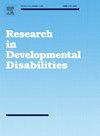经颅直流电刺激联合强化训练方案治疗单侧脑瘫患儿上肢康复。一项随机对照的初步研究
IF 2.6
2区 医学
Q1 EDUCATION, SPECIAL
引用次数: 0
摘要
背景:单侧脑瘫(UCP)表现出更大的上肢功能改变。在推荐的干预措施中,有一些治疗工具,如经颅直流电刺激(tDCS),可以增加治疗窗口,增强干预效果。目的:确定在受影响较小的半球运动皮层上进行为期3周的阴极tDCS干预,并结合上肢手动功能强化训练计划,对UCP儿童的运动质量和上肢自主使用的有效性。其次,还评估了生活质量和用户体验。方法与步骤采用随机三盲临床试验。招募18名4 ~ 8岁的UCP患儿,随机分为两组:1)活动组:阴极tDCS + 强化运动训练;2)对照组:假手术tDCS + 强化运动训练。在干预前后和随访3个月时进行评估。结局与结果结局测量:Shriners医院上肢评估儿童手操作体验问卷、儿科生活质量问卷和儿童手操作体验问卷(miniCHEQ)。两组在所有变量上均有改善,但在组间分析中,只有生活质量获得显著结果(p = 0.043)。结论和意义将阴极tDCS加入到强化的手功能治疗训练计划中,并没有对自发性使用产生更大的改善,也没有改善UCP患儿的使用体验。然而,这项技术对生活质量有短期的有益影响。本文章由计算机程序翻译,如有差异,请以英文原文为准。
Transcranial direct current stimulation combined with an intensive training program for upper limb rehabilitation in children with unilateral cerebral palsy. A randomized controlled pilot study
Background
Unilateral cerebral palsy (UCP) presents a greater functional alteration of the upper limb. Among the recommended interventions are certain therapeutic tools, such as transcranial direct current stimulation (tDCS) that could increase the therapeutic window and enhance the effect of interventions.
Aims
To determine the effectiveness of a 3-weeks intervention of cathodal tDCS applied over the motor cortex of the less affected hemisphere combined with a manual function intensive training program in the upper limbs on quality of movement and the spontaneous use of upper limb in children with UCP. Secondarily, quality of life and user´s experience was also assessed.
Methods and procedures
A pilot randomized triple-blind clinical trial was conducted. 18 children with UCP between 4 and 8 years were recruited and randomly allocated to one of the two experimental groups: 1) Active group: cathodal tDCS + intensive motor training; 2) Control group: Sham tDCS + intensive motor training. Assessments were performed before and after the intervention, and at three months follow-up.
Outcomes and results
Outcome measures: Shriners Hospital Upper Extremity Evaluation children's manual experience questionnaire, Paediatric Quality of Life Questionnaire and the Children's Manual Experience Questionnaire (miniCHEQ). Both groups improved in all variables but in the inter-group analysis only quality of life obtained significant results (p = 0.043).
Conclusions and implications
Adding cathodal tDCS to a program of intensive manual function therapy training did not produce a greater improvement on the spontaneous use, nor improving the experience of use in children with UCP. However, this technique has a short-term beneficial effect on quality of life.
求助全文
通过发布文献求助,成功后即可免费获取论文全文。
去求助
来源期刊

Research in Developmental Disabilities
Multiple-
CiteScore
5.50
自引率
6.50%
发文量
178
期刊介绍:
Research In Developmental Disabilities is aimed at publishing original research of an interdisciplinary nature that has a direct bearing on the remediation of problems associated with developmental disabilities. Manuscripts will be solicited throughout the world. Articles will be primarily empirical studies, although an occasional position paper or review will be accepted. The aim of the journal will be to publish articles on all aspects of research with the developmentally disabled, with any methodologically sound approach being acceptable.
 求助内容:
求助内容: 应助结果提醒方式:
应助结果提醒方式:


